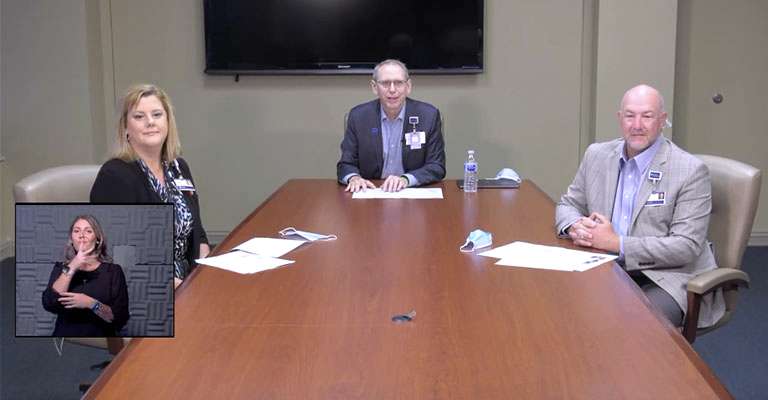
By CRISTINA JANNEY
Hays Post
HaysMed still has enough beds for COVID-19 patients despite a sharp increase in COVID cases, local health officials said Wednesday.
Dr. Heather Harris, HaysMed medical director, said the trend in the percent of positive cases in Ellis County is concerning, but is being handled by the medical community.
"We have plenty of beds, but we can get tight on staff at times," she said. "There are places outside of our COVID unit we've expanded for those who are a little less sick."
Harris and Eddie Herrman, HaysMed CEO, joined Dr. Steve Stites, KU Med's medical director, from Hays for the health system's morning COVID-19 news update.
Ellis County has had a seven-day positive rate as high as 29 percent in recent weeks. It was 18 percent as of Wednesday morning.
The tests in Ellis County are coming back anywhere from 24 hours to 10 days. When a number of tests dump into the system, it varies the rate of the positive tests, Harris said.
She said a lot of the increase has been seen in the nursing home population.
"We are at about 18 per day, so hopefully we will see a trend lower than that over the next week," Harris said.
Harris reported Hays Med had 16 COVID-19 patients as of Wednesday in the hospital. Two of those patients were in the recovery period from COVID, and no patients were on ventilators.
"The challenge for a lot of them is that they are here for a long time," she said. "When they are sick, the majority of them are here for a week or longer, just to get them recovered and feeling better.
"In medicine, we are used to people coming and going, and this virus takes a while for people to feel better."
At one point earlier this week, HaysMed had as many COVID patients hospitalized in the acute phase as KU Med, Stites said.
HaysMed serves a 23-community area. Less than half of the COVID patients are from Ellis County, Harris said. She said even small rural communities are now feeling the effects of the virus.
Herrman said the Hays' mask mandate has helped decrease the spread of the virus.
"It obviously is not going to stop it completely, but I think it has allowed us to maintain that trickle," he said. "I think we would be in a worse position in terms of how many patients we have in the hospital."
He said he thought people in the Hays community are starting to understand the importance of wearing masks.
"I think people are really starting to understand that wearing masks is for the other person's safety," Herrman said. "The mask isn't really here to help you be protected. We wear them for each other.
"You are telling your community that I care enough about you that I don't want to risk that maybe I am asymptomatic and I don't even know I have the virus."
Stites added, "It is a great way to say I love you."
The virus is finally becoming real to the people of rural Kansas, Harris said, as most people now know someone who has had the virus.
"I think people are understanding that the virus is here, and it can take some consequences," she said.
One viewer asked about her 27-year-old son who was coming to visit. He wears a mask, but his friends don't always wear masks. She wanted to know what her family should do.
Harris said this a common question she is asked because of the college students in Hays.
Harris suggested social distancing at home and having the young person use his own bathroom because he could be carrying the virus.
"I would also try to avoid visiting the 80-year-old grandparents," she said.
Dr. David Lisbon, KU Med emergency medicine physician, also joined the news briefing from Kansas City. He suggested having the young person tested for COVID-19. It is not a guarantee, but it might alleviate some fears for a short window of time, he said.
Dr. Dana Hawkinson, KU Med's director of infection prevention and control, said he knows a family who became ill with COVID-19 after a college student came home over Labor Day from college.
Stites said his 30-year-old daughter came home to visit from Chicago in June. The family tried to wear masks and social distance, but he said that lasted about five minutes and they ended up hugging.
"She's my kid. Of course I'm going to hug her. I love her. So how do you handle that?" he said.
"I think the answer is you have to establish what your risk tolerance is. Here is what we did do. My 88-year-old mother-in-law ... she couldn't be in the room, because you can't put her at risk."
Harris said patients often say in clinic they didn't feel good, but they went ahead and went to an event or work.
"Hindsight's great, but if people will really take a moment to appreciate that they are sick and they are not feeling their best that day, let's get away from those people and see what it looks like," she said.
Young people especially might not get very sick and have the symptoms of a cold, Harris said.
"We know the virus is here," she said. "We just need to keep up the social distancing and the hand washing and mask wearing, so we can try to keep the best handle on the number we can.
"As long as people try to live and move around, which we need to do, we are going to keep spreading the virus."






